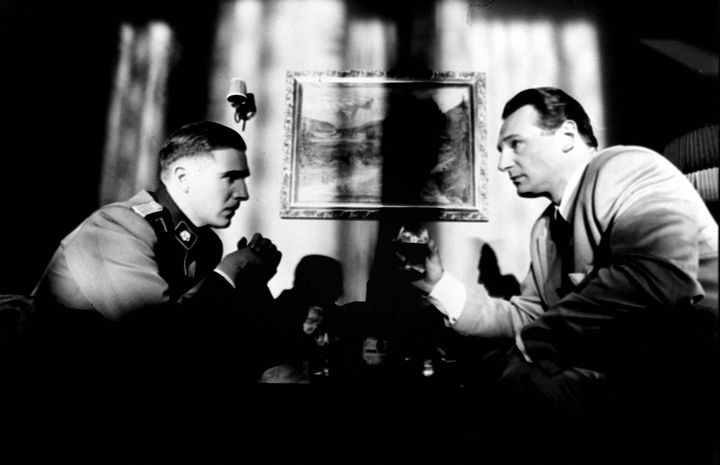
This December marks the 25th anniversary of “Schindler’s List,” the most famous, successful and influential American film about the Holocaust. Unsurprisingly, director Steven Spielberg believes that in the current climate, with Donald Trump whipping up xenophobia from the White House and a rise in far-right anti-Semitism in the U.S. and Europe, the movie is more relevant than ever. “Possibly now is even a more important time to re-release ‘Schindler’s List’ than … when it was initially released,” he told the “Today” show. “I think there’s more at stake today than even back then.”
But rewatching “Schindler’s List” right now, what’s most striking isn’t its relevance, but its uselessness. The movie offers platitudes rather than analysis, and reassurance rather than much-needed warnings. It’s meant to fortify us against hatred, but instead, it inadvertently explains why, despite our veneration for Holocaust narratives, we remain so vulnerable to fascism.
“Schindler’s List” is designed as a tool of education and transformation. The movie is based on the true story of Nazi Party member and factory owner Oskar Schindler, who saved 1,200 Jews from death in Hitler’s camps. The movie follows Schindler (Liam Neeson) as he develops from a self-centered, greedy businessman and philanderer into a man driven by justice and righteousness. Witnessing the Holocaust makes Schindler a better man. It’s supposed to make viewers into better people, as well.
“Rewatching 'Schindler’s List' right now, what’s most striking isn’t its relevance, but its uselessness.”
Schindler’s transformation begins in a scene in which he and a girlfriend take a horseback ride and accidentally witness the Nazi liquidation of the Krakow ghetto. Schindler watches the violence just as the viewer watches the violence. He furrows his brow and narrows his eyes in pain, just as you are supposed to furrow your brow and narrow your eyes. He models empathy and sorrow so that viewers will know to empathize, and whom to empathize with, when fascism comes again.
Teaching people to empathize with victims is a worthy goal. But when the empathy is too easy, it can lead to complacence. “Schindler’s List” makes us feel like we’re ready to recognize and deal with fascism, when we’re not. That’s the opposite of helpful.
For all its pathos and earnestness, the movie is too glib in its handling of the Nazis. The concentration camp commandant, Amon Goeth (Ralph Fiennes), is a sadistic monster who performs cinematic and dramatic acts of brutality to signal to the viewer that he is pure evil. In real life, when Nazis and their ilk are trying to gain power, they often lie about their motives or their goals, and use dog whistles to rally support. They talk incessantly about black crime rates, or, in the Nazis’ case, about Jewish crime rates, in order to create a consensus for strong-arm law-and-order policies.
But you don’t need to deconstruct Nazi ideology or understand racist dog whistles to condemn the Nazis in “Schindler’s List.” You just need to watch as Goeth takes up a sniper position and shoots anyone in the camp who happens to pause for a rest. It’s no harder than rooting against Lex Luthor or the Joker.
Meanwhile, the Jewish victims are a friendly, deindividualized mass of Capra-esque bonhomie and virtue, obligingly performing heartwarming schtick in the face of adversity. “It could be worse,” one woman says on seeing her tiny, filthy new ghetto apartment. “How could it be worse!” her husband exclaims with hyperbolic vaudeville timing. The Jewish people in the film don’t try to resist or kill their German oppressors. They don’t even express much in the way of hatred or resentment.
In “Schindler’s List,” Jewish people are always object lessons, never conscious teachers. No Jewish character criticizes or explains the evils of Nazi propaganda. These Jews never talk about how they experience prejudice, or what they would need to fight it.
“In 'Schindler’s List,' Jewish people are always object lessons, never conscious teachers.”
There is one conversation in the film in which a Jewish person confronts a German about prejudice — except that the Jewish person in question doesn’t even speak. In the scene in question, Goeth debates with himself whether to rape his Jewish maid. He takes both sides of the argument: On the one hand, Jewish people aren’t human, but on the other, he says, quoting Shylock, “Hath not a Jew eyes?” He imagines his housekeeper speaking in defense of Jewish humanity, but in fact, she says nothing. Instead, she stands paralyzed with terror, breathing heavily in a semitransparent shift, sexualized and objectified, until he resolves his internal argument with a beating rather than a rape.
Similarly, the Jews around Schindler only beg him to save their relatives, or praise him for his bravery. They never insist on their rights. It’s Schindler who orders his workers to take off for Friday prayers. He demands that they be good Jews. They only hope that he will be a good gentile. It’s true that some Jews mistrust him at first, but that quickly mellows into love and gratitude.
“Schindler’s List,” then, tells its viewers that when fascism comes, they will find it easy to pick the right side, and that fascism’s targets will be ― and should be ― quiet and grateful.
But, as we are discovering anew, all of this is false. Fascist demagoguery targets people who are disliked and despised by playing on partisanship and existing hatred and fear. A Fox News commentator claims that immigrants will carry smallpox into the U.S. in order to activate anti-immigrant bigotry. Tucker Carlson lies about left protesters attacking his home in order to stir up ambient mistrust of leftists, which the Nazis also used to great effect. Fascists make reasonable-sounding appeals to shared values — for example, by claiming that Nazi alt-right rallies are actually about free speech. Fascists don’t just murder people in the street. At least, not too many. Not at first.
“The movie tells its viewers that when fascism comes, they will find it easy to pick the right side.”
Fascism appeals to the prejudices and partisan identities of white people. Empathy alone is not enough to combat it, because empathy is generally directed first and foremost to the powerful. That’s why “Schindler’s List” has a rich gentile as its protagonist in the first place. Spielberg is Jewish himself, but he, and presumably the studio, didn’t think that viewers could put themselves directly in the place of victims.
To fight fascism, you don’t just need to feel — you need to listen. The targets of fascism are the people best able to express what is happening to them, and what they need to fight it. But “Schindler’s List” presents victims as supplicants. It doesn’t model any way to show support for journalist Jemele Hill, who fell out with her network for saying that Trump is a white supremacist. It doesn’t push you to show solidarity when anti-racist activists demand that Confederate monuments be taken down. It doesn’t tell you that anti-fascist actions are important — even when they disrupt someone’s meal. The virtuous victims in “Schindler’s List” never protest. Because of this kind of representation, it’s easy for people to claim that protesters aren’t virtuous.
“Schindler’s List” doesn’t even provide a useful lens for understanding America’s recent uptick in anti-Semitic attacks, including a recent bombing attempt against billionaire George Soros. Soros is in many ways the most high-profile target of anti-Semitism today. He is at the center of numerous far-right conspiracy theories, and Trump himself blamed Soros for supposedly paying demonstrators protesting Supreme Court nominee Brett Kavanaugh. That was a lie. But Soros does use his resources to advance progressive causes. He’s got political opinions and the wherewithal to support them. He’s not passive, but he’s a target. Standing with him is not an exercise in noblesse oblige, but in solidarity. “Schindler’s List” doesn’t teach that.
“Fascists don’t just murder people in the street. At least, not too many. Not at first.”
You could argue that “Schindler’s List,” while not perfect, is better than nothing. It condemns fascism in a simplistic way, but it condemns it. It models support for victims in a limited way, but it still models it.
But just as a little knowledge can be a dangerous thing, so can a sentimentalized, unrigorous anti-fascism go badly awry. When fascists are presented as completely unsympathetic villains, it becomes difficult to recognize the danger of hatred in your pleasant neighbor. When victims are supposed to be passive and receptive, you’re likely to become angry when Jewish people, or black people, or trans people, point to your friends or allies, or to you, and say, this is a danger to me. Don’t do that.
Sentimentality and self-satisfaction undermine the critical skills and courage needed to oppose fascism when it comes. “Schindler’s List” isn’t solely responsible for our understanding of fascism today, or for our current politics. But it has played a part in both. Twenty-five years on, the main lesson of “Schindler’s List” is that we need to build a better anti-fascism than the one Spielberg gave us.
Noah Berlatsky is the author, most recently, of Nazi Dreams: Films About Fascism.
